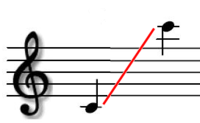Xaphoon
|
Xaphoon | |
| Woodwind instrument | |
|---|---|
| Classification | |
| Hornbostel–Sachs classification |
422.211.2 (Single reed with cylindrical bore with fingerholes) |
| Inventor(s) | Brian L. Wittman |
| Developed | 1972 |
| Playing range | |
 | |
| Related instruments | |
| Builders | |
| Maui Xaphoon | |
A xaphoon (pronounced "za-foon"), is a chromatic "Bamboo Sax" or single-reed instrument/woodwind instrument. It has a straight cylindrical tube with cylindrical bore and a very slightly flared bell. The xaphoon plays a fully chromatic scale somewhat beyond two octaves, and overblows at the 12th, like a clarinet.

The first xaphoon, made out of bamboo in 1972, was a spontaneous effort by Brian Wittman (a Hawaiian saxophonist and multi-instrumentalist) to create an instrument for a young child who liked the sound of the saxophone. Wittman was impressed by the sound of the simple instrument and by demand started to manufacture and sell it.[1]
The design of the xaphoon is patented.
The range of the xaphoon happens to be comparable to the chalumeau, a European keyless single-reed instrument that was the ancestor of the clarinet; therefore the Xaphoon can be used to play written chalumeau music, as well as music in any other style associated with the saxophone or clarinet. In addition to the chalumeau, similar instruments bearing other names exist in other regions. These include the Heping Flute 和平笛 and the Ebi (from Yunnan), both of which use the design of putting a single reed on a Dongxiao, a vertical flute. Other variations include various bamboo/pocket/mini saxes that include an actual saxophone mouthpiece (sometimes connected at a curve.)
Due to its abbreviated length and large finger-hole size, the pitch of individual notes can be raised and lowered easily, making the xaphoon equally well-suited to play Turkish, Middle Eastern, and other musical scales outside the European tradition. The xaphoon has been made commercially available by Brian Wittman since 1975; Wittman still makes approximately 1500 bamboo instruments per year by hand at his home on the island of Maui, Hawaii, using local bamboo selected from the forests of the eastern end of the island.
Use and availability
The xaphoon is available from Maui Xaphoon (Brian Wittman's company) in the keys of C, B♭, D, and G (as well as any other key via special order). It uses a standard tenor saxophone reed. Its body is 12.5 inches / 32 cm long (for the instrument pitched in C) and has nine holes (eight holes in front, and one hole in back for the left thumb) that resemble those of a recorder. The xaphoon's fingerings, however, are significantly different from those of either a saxophone or recorder.
Plastic issue "Pocket Sax"
In the spring of 2000, a molded ABS version of the xaphoon following Wittman's patented design was introduced. These instruments are made under license by Indiana Plastics of Elkhart, Indiana, and are marketed under the trade name Xaphoon Pocket Sax. Currently, it is available in the key of C, with its lowest tone being C below middle C. The instrument is sturdy, and the reed can be protected by a cap when not played.
In the spring of 2012, Wittman began a collaboration with Francesc Sans Sastre, a long-established luthier in Sant Jaume de Lleirca, Girona, Spain to produce hand-made wooden xaphoons in strict accordance with the original xaphoon design. A limited number of these collector instruments will be made available in coming years under the name "Xaphoon de Catalunya".
While the popularity of the xaphoon has led to frequent use of the word "xaphoon" to denote any type of small single-reed keyless woodwind instrument, the term remains a registered trade name. Only those instruments produced by Brian Wittman (Maui Xaphoon), Indiana Plastics (Xaphoon Pocket Sax), and Sans Luthier (Xaphoon de Catalunya) are allowed to be called xaphoons.
Trademark and patent
"Xaphoon" is a registered trademark (Trade Name – Hawaii File Number 116995D1,Trade Mark – Hawaii File Number 50914ZZ), owned by Brian Wittman under the Hawaii-based sole-proprietorship "Maui Xaphoon". The instrument is patented under US Patent D262035.[2]
See also
Notes
- ↑ "How the Xaphoon is Made". Maui Xaphoon. Retrieved 2012-12-25.
- ↑ "US Patent: Wind instrument". Brian L. Wittman. Retrieved 2012-12-25.
External links
Listening
- Video of all the xaphoon sounds (flute, sax, bruitism)
- xaphoon sound panorama
- xaphoon sound
- Xaphoon Sound Example: Bei Mir Bist Du Schon
- Video – Nobody Knows The Trouble I've Seen
